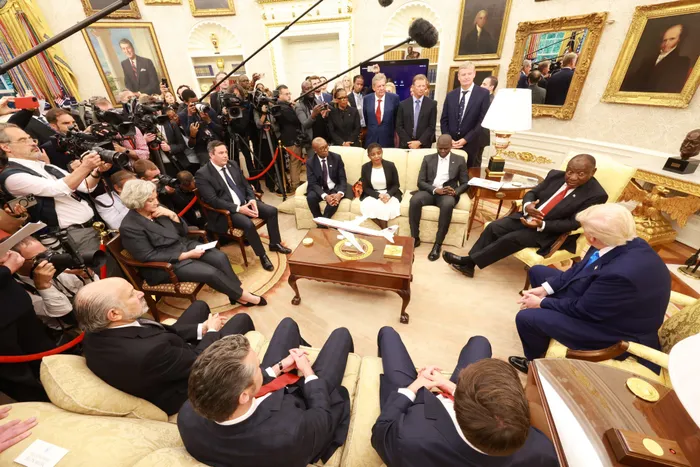Ramaphosa's White House blunder: Chaos and missed chances

South Africa's diplomatic blunder: A missed opportunity at the White Housee
Image: GCIS
SOUTH Africa's diplomatic outing to the White House on Wednesday has been widely criticised as a humiliating chapter in the country's international relations, exposing a lack of preparation, coordination, and strategic messaging.
The visit, led by President Cyril Ramaphosa, was meant to defend South Africa’s reputation amid unfounded allegations of genocide and to counter growing US criticism. Instead, it has become a symbol of diplomatic disarray.
On Wednesday, Ramaphosa met with US President Donald Trump in the White House, a session marred by awkward moments and uncoordinated responses.
The meeting followed Trump’s provocative claims linking South Africa to “genocide” and his controversial decision to offer refugee status to minority white farmers, claiming they faced persecution.
Ramaphosa’s delegation included a curious mix of officials and personalities.
Minister of International Relations and Cooperation Ronald Lamola, Minister in the Presidency Khumbudzo Ntshavheni, Minister of Trade Parks Tau, and Minister of Agriculture John Steenhuisen, who is also the leader of the Democratic Alliance.
Alongside them, golf legends Ernie Els and Retief Goosen, business leaders Johann Rupert and Adrian Gore, and COSATU President Zingiswa Losi sought to bolster South Africa’s image.
However, the delegation’s performance was widely regarded as ineffective. At one point, Trump turned to the golfers, prodding Goosen for his opinion.
The golfer responded that his relatives on farms lived behind electric fences in fear of crime - an anecdote that only reinforced the perception of chaos and violence rather than dispelling it.
Silent Diplomacy and Missed Opportunities
Political analysts observed that what stood out most was the absence of clarity from South African officials in the core diplomatic team.
Lamola, Ntshavheni, and Tau remained silent during the exchanges, failing to articulate South Africa’s official stance or challenge false narratives.
Losi attempted to shift the conversation by emphasising that crime is a universal issue, not racially targeted. Still, analysts felt her remarks lacked depth and impact as they only painted the country as a violent nation.
Steenhuisen sought to defend the country by highlighting his party's coalition role and opposition to the parties representing predominantly black Africans, the EFF and the MK party.
According to political pundits, this strategic misstep did little to highlight that the Constitution allows for political participation and freedom of speech.
Meanwhile, the delegation's ineffective approach and clarity left many observers questioning whether South Africa was adequately prepared.
Analysts Criticise the Lack of Strategy
Geopolitical analyst Joe Mhlanga criticised the delegation’s approach.
“This visit was a missed opportunity. The fact that even the President said Trump asked the golfers to be brought along with this delegation showed a lack of seriousness.
“Trump perceives South Africa as run by a white minority, and the delegation failed to articulate South Africa's true position effectively.”
Mhlanga further pointed out that the delegation appeared to be reacting on the spot rather than presenting a unified, strategic front.
“They should have had prepared responses, especially regarding the false claims about genocide and land reform,” he added.
“Instead, they gave weak answers, and the foreign minister said nothing substantive.”
Failure to Defend South Africa’s Reputation
Professor Christopher Isike from the University of Pretoria highlighted the delegation’s failure to clarify key issues.
“There was an opportunity to state clearly that there’s no evidence linking political songs or land reform to violence or genocide,” he noted.
“The absence of such clarifications only allowed false narratives to gain traction.”
He argued that the delegation also failed to demonstrate South Africa’s demographic and social realities, neglecting to provide visuals or data that could dispel misconceptions.
He said that they appeared passive and unprepared instead of showcasing the country's progress and diversity.
Contradictions and Lack of Cohesion
Adding to the diplomatic chaos, just days earlier, Minister of Mineral Resources Gwede Mantashe declared during the minerals briefing in parliament that South Africa would not hand over critical minerals to the US.
Yet, during the White House meeting, President Ramaphosa suggested cooperation, highlighting a disconnect within the government.
This internal lack of coordination was further underscored by the absence of clear messaging on crucial issues like land reform and economic inequality, which are central to South Africa’s national discourse.
A Nation at Risk of Further Damage
The consequences of this diplomatic misstep extend beyond the immediate.
As Mhlanga warns, “South Africa needs to be able to debate globally without compromising its interests. This disorganised approach damages our credibility and invites further criticism.”
Professor Isike emphasised that the country failed to correct misconceptions and present its narrative convincingly.
“This was a moment for leadership, an opportunity to defend our sovereignty and explain our policies. Instead, we saw confusion and silence.”
Related Topics: